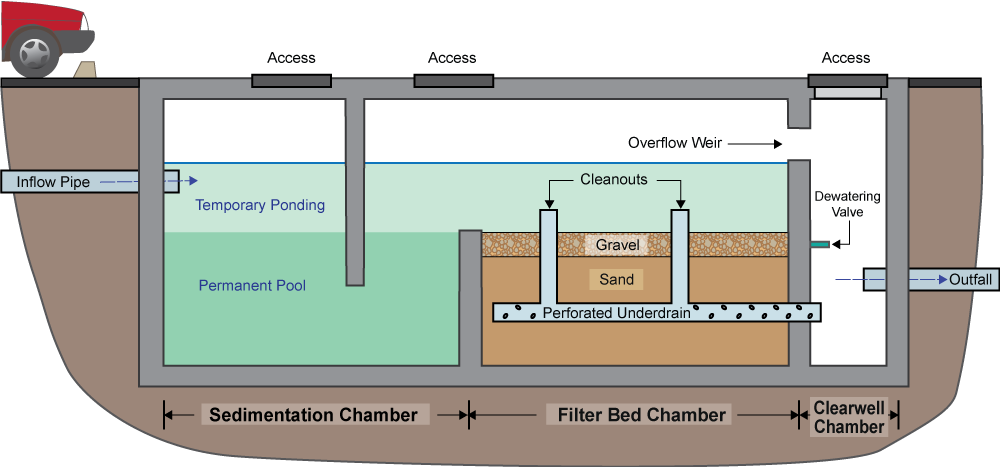 Protecting our environment, one stormwater practice at a time.
Protecting our environment, one stormwater practice at a time.
Filtering Practices
Overview
Stormwater filtering practices capture, temporarily store and treat stormwater runoff by passing it through an engineered filter media, collecting the filtered water in an underdrain, and then returning it to the storm drainage system. Stormwater filters are used to treat stormwater runoff from small, highly impervious sites. Filtering practices can be a versatile option because they may use little surface land and have few site restrictions. The filters consist of two chambers: the first is devoted to settling and the second serves as a filter bed consisting of a sand or organic filter media. Stormwater filters can be either aboveground or underground.
How Filtering Practices Work
Filtering practices are designed only for water quality treatment. Stormwater filters depend mainly on physical treatment mechanisms to remove pollutants from stormwater runoff, including settling in the sedimentation chamber, straining at the top of the filter bed, and filtration and adsorption onto the filter media. Microbial films often form on the surface of the filter bed, enhancing biological removal. Stormwater filters can be classified into several broad categories.

Surface Sand Filters (example: Austin Sand Filter)
Surface sand filters require as much land as a dry pond or bioretention basin and are ideal in less urbanized areas. Stormwater is channeled into the facility and flows through a series of energy-reducing structures into the sedimentation basin. Water then enters the filtration basin before exiting through an outfall pipe. The sedimentation basin and filtration basin are both located at ground level. These types of sand filters are normally designed so that only the desired water quality volume is directed to the filter for treatment.

Underground Sand Filters (example: DC Sand Filter)
Underground sand filters are expensive to construct but take up little space and are well suited in ultra-urban environments. These types of facilities consist of an underground vault divided into several chambers. Stormwater is piped into the sedimentation chamber, flows into the filter bed chamber and exits via the clearwell chamber. An internal flow splitter or overflow device bypasses runoff from larger storm events around the filter bed chamber and into the clearwell chamber.

Perimeter Sand Filters (example: Delaware Sand Filter)
This type of sand filter is similar in design to the underground sand filter. Stormwater enters the sedimentation chamber through a series of grates or a curb inlet at the edge of a parking lot, flows into the filter bed chamber and exits via the clearwell chamber. An overflow weir bypasses runoff from larger storm events around the filter bed chamber and into the clearwell chamber.
How to Maintain a Filtering Practice
Visual inspections should be completed on a routine basis and maintenance performed as needed.
- Ensure structural components of the facility are in good working order and repair and replace as needed
- Check inflows for blockages and clear as needed
- Remove accumulated sediment, litter and debris regularly from the sedimentation chamber
- Regularly open and close the dewatering valve in the clearwell chamber to prevent corrosion
- Ensure the dewatering valve is in the closed position unless performing maintenance
- If standing water is observed on the surface of the filter bed 48 hours after a 1/2 inch rain storm, then the media or the underdrain may be clogged, which impacts the draw-down rate of the facility. In either case, consultation with a qualified professional is recommended. Any clogging must be addressed to maintain facility function.
FairFacts
- One of the target pollutants of filtering practices is phosphorus. Excess phosphorus is one of the most prevalent pollutants in the Chesapeake Bay, leading to algae blooms that block sunlight and use up the oxygen available for the aquatic plants and organisms in the Bay.
- The three types of filtering practices are named after the localities for which they were first designed:
- Austin-surface
- DC-underground
- Delaware-perimeter.
- Filtering practices are suitable for use in stormwater hot spots. A stormwater hot spot is an area where land use or activities may generate contaminated runoff with increased pollutant concentrations.
The information in this fact sheet is general in nature and is not intended to determine maintenance responsibility.
For more information, contact:
Department of Public Works and Environmental Services, Maintenance and Stormwater Management Division
10635 West Drive, Fairfax, VA 22030
703-877-2800, TTY 711
ContactMSMD@fairfaxcounty.gov

